Expert’s Rating
Pros
- Excellent screen quality
- Sleek, tactile design
- Super fast wired and wireless charging
- User-friendly software experience
Cons
- Curved screen false inputs
- Middling secondary cameras
- Longer software support available elsewhere
Our Verdict
Whether it deserves the Pro designation or not (it probably doesn’t), the Motorola Edge 50 Pro is one of the most aesthetically pleasing mid-range phones on the market, while its display, software, and charging provisions are among the best. You can get better cameras, performance, and battery life for the money if those are important to you.
Price When Reviewed
Not available in US
For the longest time, Motorola was best known for its cheap and cheerful Moto G phones, but the Lenovo-owned brand has been quietly making a name for itself a little further up the pricing scale of late.
The Motorola Edge 50 Pro is another example of a classy mid-ranger with a couple of flagship-level features. Even so, it might not be quite what you’re expecting.
Motorola has had a bit of a rethink about the positioning of its three smartphone offerings in 2024. The Motorola Edge 50 Pro isn’t actually a direct follow-on from the flagship Motorola Edge 40 Pro from 2023, but rather is far closer in price and spec to the mid-range Motorola Edge 40.
For £599 you’re getting a good-looking phone with a great display, rapid charging, crisp software, and a proper triple camera set-up. Of course, this isn’t the only ‘premium mid-range’ smartphone on the market… but is it the best?
Motorola is now firmly in the business of making classy phones available at reasonable mid-market prices
Take a look at the handsets the Edge 50 Pro must compete with in our best mid-range phone chart.
Design & Build
- Vegan leather back
- Slim and lightweight
- IP68 rated
As has become a signature feature of the Edge series, the Motorola Edge 50 Pro looks and feels delightful.
It has that just-so feel in the hand, partly down to a thickness of 8.19mm and a weight of 186g. It’s in that Goldilocks zone where it feels substantial but not unwieldy.
Another factor in the phone’s pleasant feel is its vegan leather back. Its pronounced texture lends grip, resists greasy marks (at least on my Luxe Lavendar model), and feels warm and inviting. You can also pick the phone up in Black Beauty and Moonlight Pearl, the latter of which switches the rear material to a more traditional form of plastic.
as water and dust resistant as many a £1,000-plus flagship
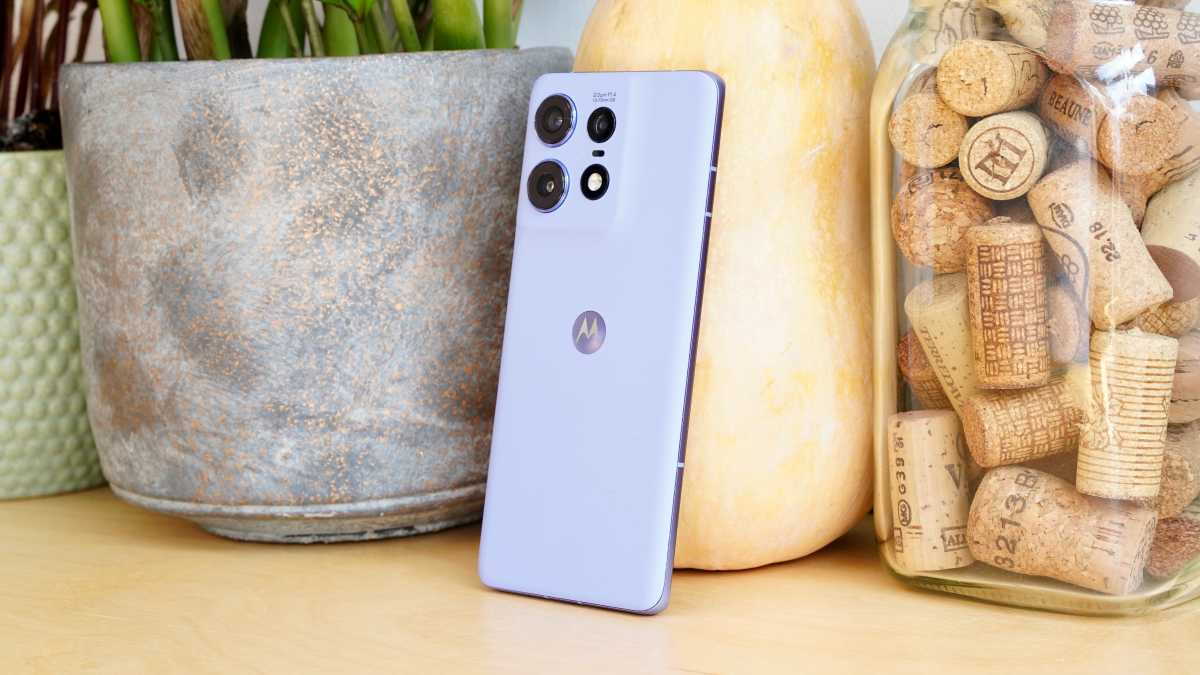
Jon Mundy / Foundry
Whatever finish you opt for, the camera module steadily melts into the body rather than standing out like Table Mountain – similar to the Samsung Galaxy A53 – which is an approach I can get behind. You also get a sandblasted aluminium frame, which is suitably premium.
The sense of quality continues with an IP68 rating, which makes the Motorola Edge 50 Pro as water and dust resistant as many a £1,000-plus flagship.
Another prominent design feature is the phone’s dual-curved display. I’ll discuss the practical repercussions of this in the next section, but it undoubtedly looks the part at least.
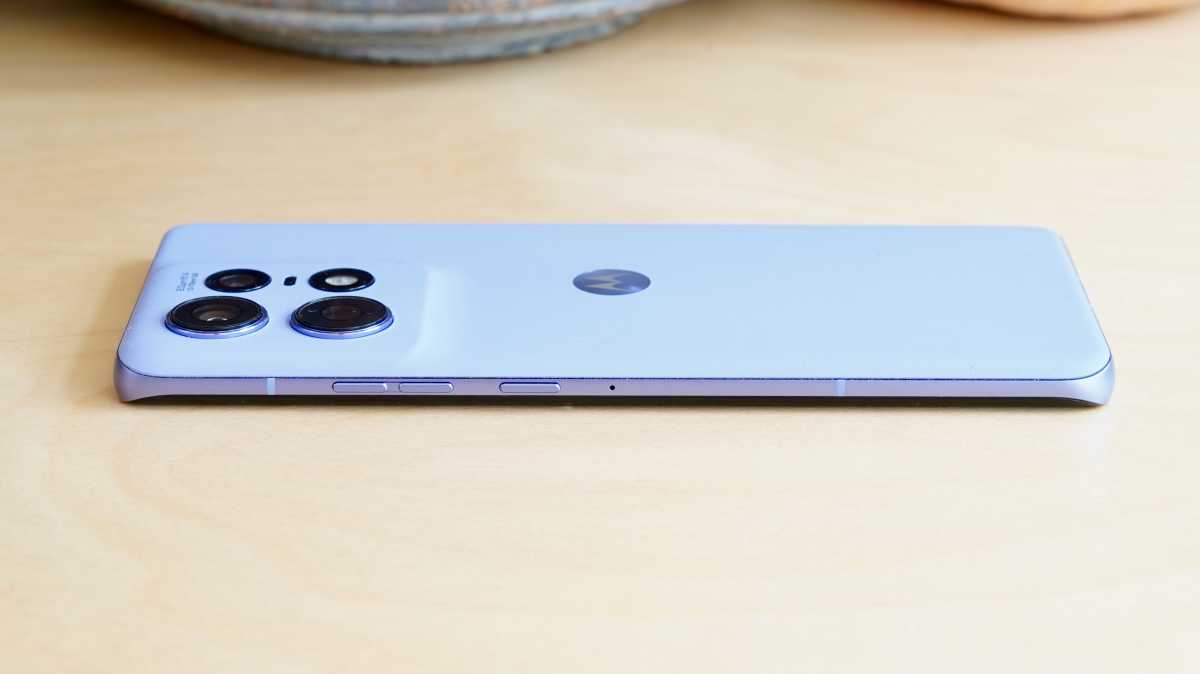
Jon Mundy / Foundry
Screen & Speakers
- Sharp ‘1.5K’ 144Hz pOLED
- 6.7-inch
- Clear stereo speakers
Motorola has been going the extra mile with its Edge displays for a while now, and the Motorola Edge 50 Pro continues the good work. It’s a large, vibrant 6.7in LTPS pOLED panel with a variable refresh rate.
You can leave it to automatically adjust the refresh rate by default, or else manually choose between 60-, 120-, and 144Hz. I cranked it right up to the max for the test period, as is the Tech Advisor way, but as always Motorola has probably gone a little OTT with that 144Hz figure – 120Hz is plenty. Gamers will benefit from a 360Hz maximum touch rate, which should ensure responsive performance in fast-paced games.
Motorola has improved the Edge 50 Pro screen in two main areas. For one thing, it packs a sharper 2712 x 1220 resolution, which many would call ‘1.5K’. This offers a nice balance between FHD+ and QHD+ (aka 2K), resulting in nice crisp text and well-defined image previews.
The other improvement relates to colour accuracy
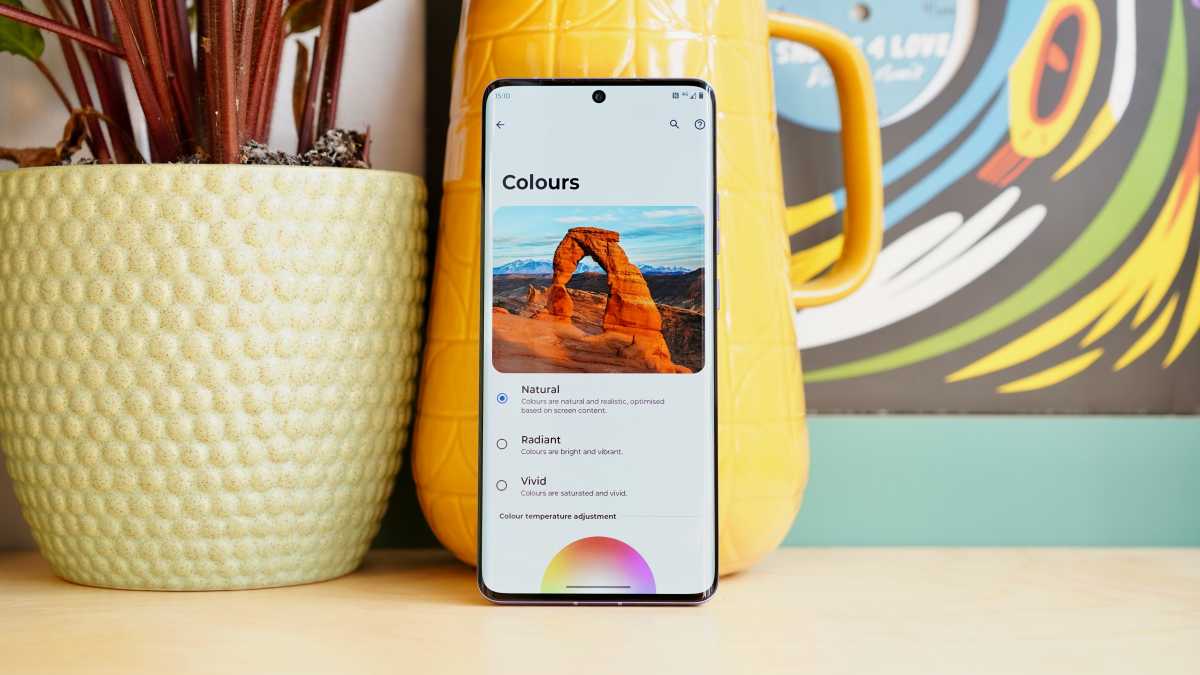
Jon Mundy / Foundry
The other improvement relates to colour accuracy. Motorola is making a big deal out of its ‘Pantone Validated colour’, which sounds like a gimmick, and it might well be. All I can attest to are the facts and figures, which include an sRGB gamut coverage of 99.5% and an average Delta E of 0.64. That’s exceptional.
True, you’ll need to switch away from the default Vivid colour scheme and select the Natural alternative in order to hit these more accurate figures, but that’s the case with virtually every Android phone I’ve ever tested.
Brightness is solid too, with a claimed peak brightness of 2000 nits in HDR scenarios (there’s support for HDR10+). With autobrightness turned off, I recorded a maximum brightness of around 472 nits, which is decent.
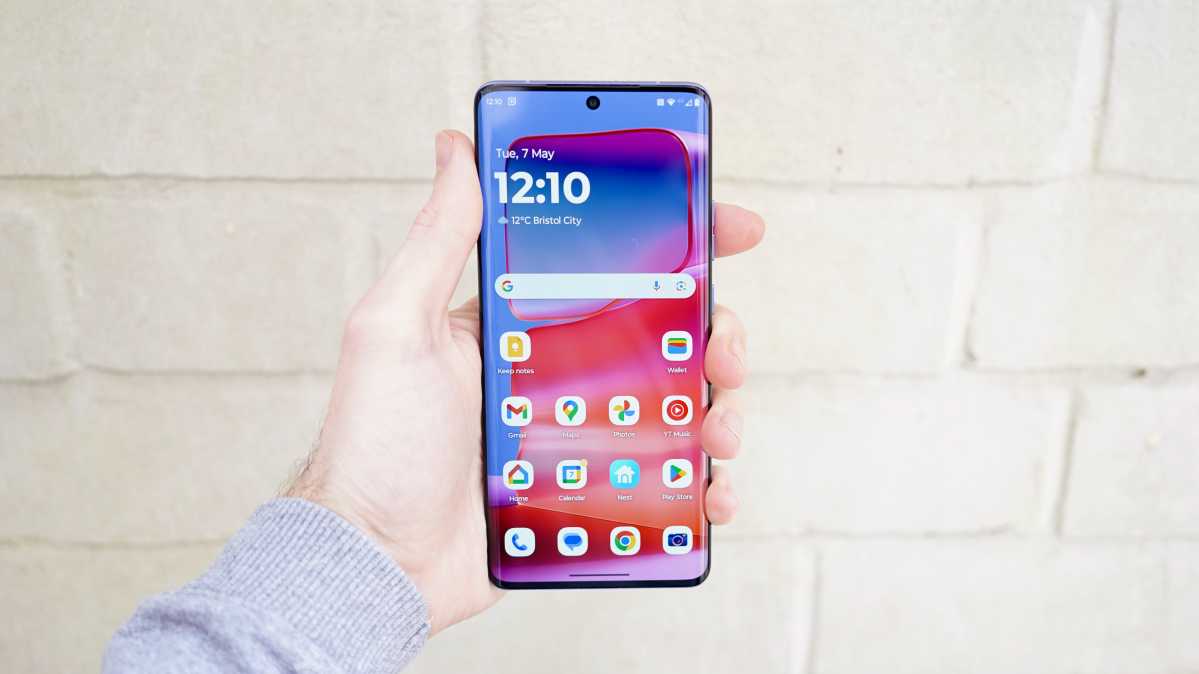
Jon Mundy / Foundry
My one criticism of the Motorola Edge 50 Pro screen is a familiar one. The choice to use a dual-curved display may have produced a handsome phone, but I encountered plenty of false input issues during my couple of weeks with it. There were plenty of occasions where a screen press simply wasn’t registering, only for me to realise it was because a portion of my holding hand was already making contact with the edge of the display.
Motorola has also included a pair of Dolby Atmos-tuned stereo speakers, which yield impressively loud and spacious audio. I was particularly impressed by the clarity of vocals in movie content. There’s no 3.5mm headphone jack, for whatever that’s worth to you.
Specs & Performance
- Snapdragon 7 Gen 3
- 12GB LPDDR4X RAM
- 512GB storage
Motorola has turned to Qualcomm’s latest mid-range chip, the Snapdragon 7 Gen 3, to power the Edge 50 Pro.
It’s a capable processor, though benchmark tests suggest that performance has actually taken something of a backwards step even from last year’s vanilla Motorola Edge 40 and its punchy MediaTek Dimensity 8200, never mind the Motorola Edge 40 Pro with its Snapdragon 8 Gen 2.
Even in advanced games the Motorola Edge 50 Pro proved up to the task
It also falls well behind the similarly priced Nothing Phone (2) with its Snapdragon 8 Plus Gen 1 processor. Of course, in each of these cases, the Motorola Edge 50 Pro is running a sharper display, which is going to take a chunk out of GPU performance. Even so, with that Pro moniker, you might have expected more impressive performance.
What really matters is how the Motorola Edge 50 Pro handles those extra pixels, especially at elevated refresh rates of up to 144Hz, and the answer is well enough. At no point during my time with the phone did I find it lagging or dropping frames of animation when skimming through the UI.
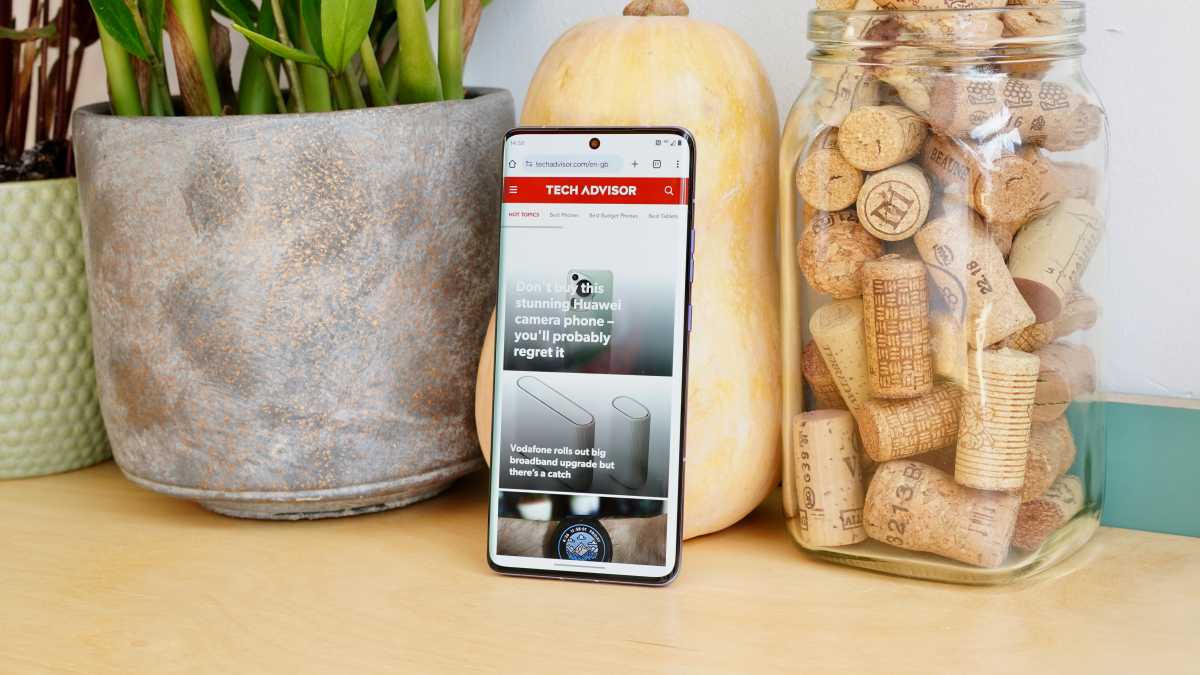
Jon Mundy / Foundry
The provision of 12GB of LPDDR4X RAM (at least here in the UK) no doubt helps with that, as does Motorola’s delightfully lightweight UI.
Even in advanced games the Motorola Edge 50 Pro proved up to the task. Running both Wreckfest and Genshin Impact on ‘High’ settings, the phone didn’t break a sweat, and largely hit its 60fps target.
There’s ample storage for such hefty apps too, with the sole UK model coming with an impressive 512GB of internal storage. That’s a better stock provision than most flagship phones.
Cameras
- Main 50Mp f/1.4 sensor
- 13Mp ultra-wide
- 10Mp 3x telephoto
- 50Mp selfie cam
For the Edge 50 Pro’s camera set-up, Motorola appears to have essentially replicated the Motorola Edge 40’s main and ultra-wide, added a dedicated telephoto, and upgraded the selfie camera. Maybe that’s a bit of an oversimplification – there’s also a new ToF (time-of-flight) sensor for superior autofocus – but the main sensor certainly performs similarly.
Once again, that unusually fast f/1.4 aperture is good for scooping up light, in conjunction with a reasonably large 1/1.55-inch sensor. I was impressed by the separation and natural bokeh captured when shooting human subjects, even without employing the Portrait mode. However, it can also mean that elements of close-up shots stray out of focus.
The 10Mp telephoto is the newcomer here and is a rare find for a phone in this price bracket
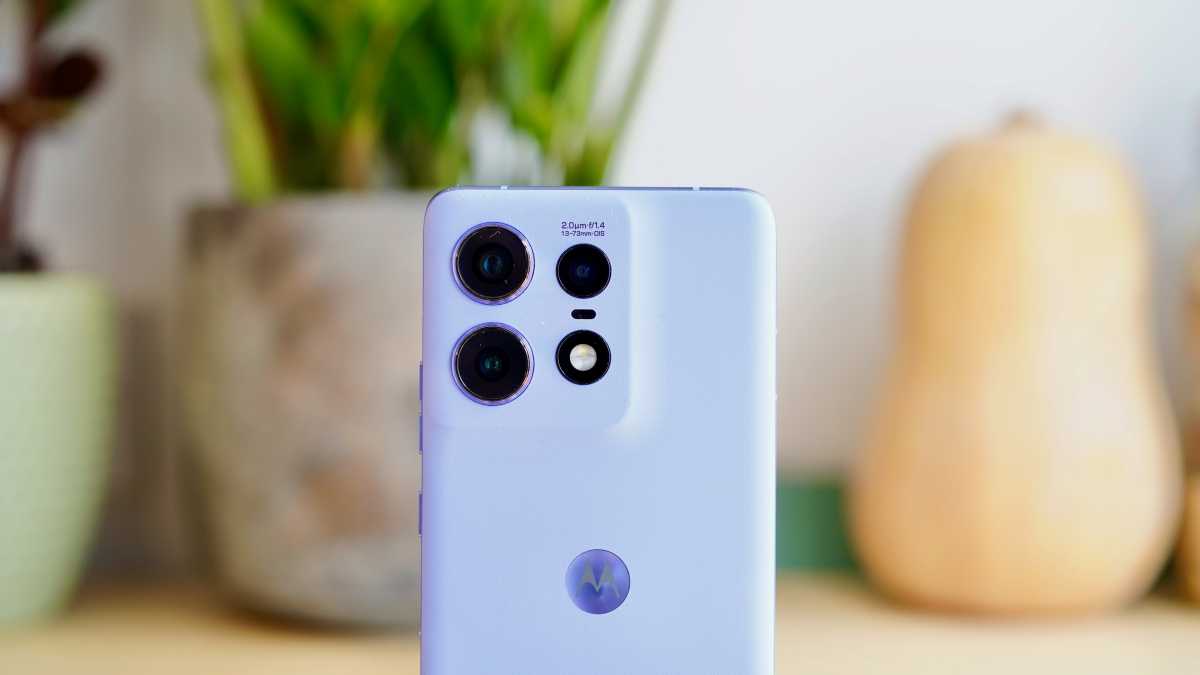
Jon Mundy / Foundry
In strong daylight, the Edge 50 Pro’s main sensor takes good shots, while that combination of components also results in some pretty nice results in indoor lighting. The dedicated Night mode isn’t the strongest I’ve encountered at the price, though I appreciate that Motorola resists pulling the cheap over-brightening trick that can make everything look unnatural in cheaper phones.
The 10Mp telephoto is the newcomer here and is a rare find for a phone in this price bracket, but you won’t encounter it until you zoom in to 3x. At 2x, the Edge 50 pro simply crops in on the larger main sensor. This results in 2x shots that are far better exposed and just plain easier on the eye than their 3x brothers, which tend to be dimmer and flatter. Still, it’s a welcome inclusion in a phone of this price.
The 13Mp ultrawide is similarly murky, lacking the vibrant pop of that main sensor. It can do a job on landscapes, but the 50Mp main sensor really is the star attraction here. Indeed, you might prefer to employ the ultrawide’s autofocus capabilities in the service of relatively sharp macro shots.
Motorola’s 50Mp selfie camera can produce good shots with natural screen tones and decent subject sharpness, complete with autofocus – something of a rare inclusion on a more affordable phone – and it can also switch between a closer view and a wider one.
I did pick up on the occasional bodged selfie where the exposure was way too dark, but thankfully this was a rare fumble.
Video capture tops out at the usual 4K at 30fps, though most people will likely still with 1080p at either 30- or 60fps. Motorola also supports HDR10 recording, though only at 30fps.
Battery Life & Charging
- Slightly pokey 4500mAh battery
- Ridiculously speedy 125W charger included
- 50W wireless charging
Battery life is something of a mixed bag in the Edge 50 Pro.
On the positive side, the phone is nice and efficient in general usage, and I was able to get through a day of moderate use (4 hours 30 minutes of screen on time) with around 50 to 60% left to play with.
On the other hand, the PCMark Work 3.0 battery test – which simulates a sustained mixed workload – produced a fairly poor result of 9 hours 34 minutes. That’s better than the Edge 40, but more than an hour short of the Pixel 8 (now available for a similar price), and almost 5 hours short of the Nothing Phone (2).
Of course, none of those other phones run a 144Hz display. Peg that setting back to Auto, or even 120Hz, and you’ll get a much better score, though still not among the very best.
Motorola bundles in a ridiculously speedy 125W TurboPower charger
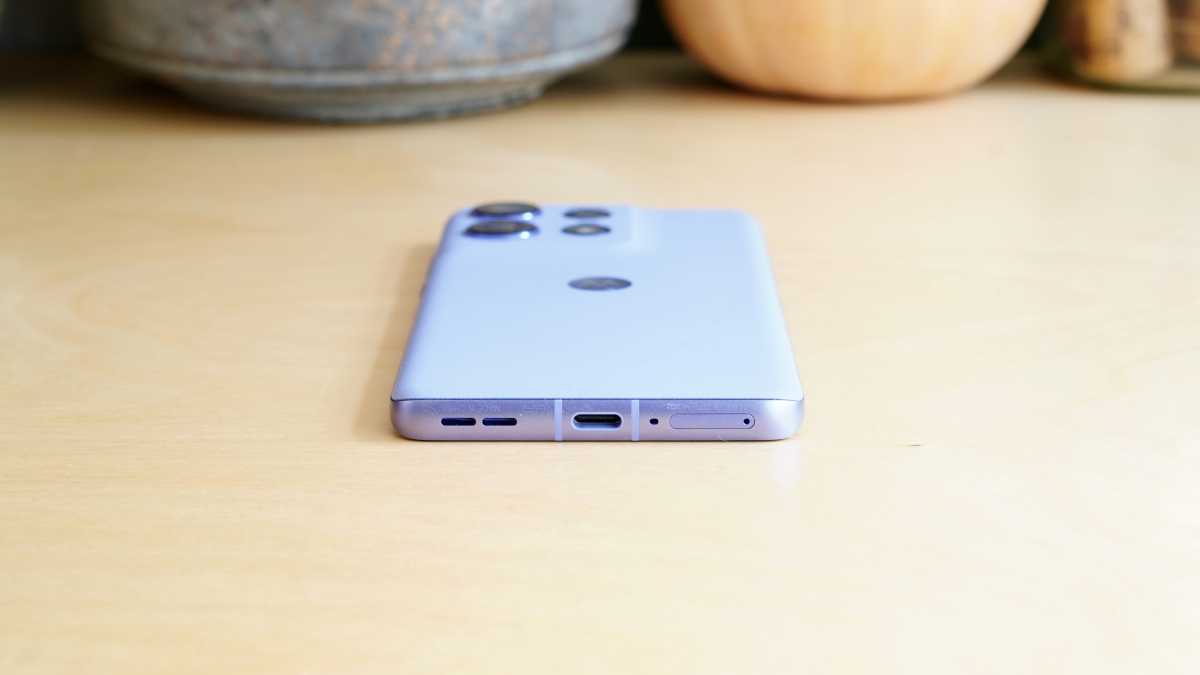
Jon Mundy / Foundry
The takeaway seems clear here: the Motorola Edge 50 Pro’s smaller-than-average 4500mAh battery is more than up to the task of lasting through a day of lighter everyday tasks, but struggles a little when the going gets tough.
Thankfully, it also features one of the best charging provisions of any phone of this price – or any price, for that matter. Motorola bundles in a ridiculously speedy 125W TurboPower charger, which can get the phone from empty to full in less than 20 minutes.
You also get 50W wireless charging support, which is another provision you don’t expect to see at this end of the market. All in all, it makes Samsung’s and Google’s modest charging provisions look a bit silly. One of its only rivals in this area is the 120W Xiaomi Redmi Note 13 Pro+ which doesn’t have wireless charging.
Software & Apps
- Customary clean take on Android 14
- Thoughtful Motorola…
